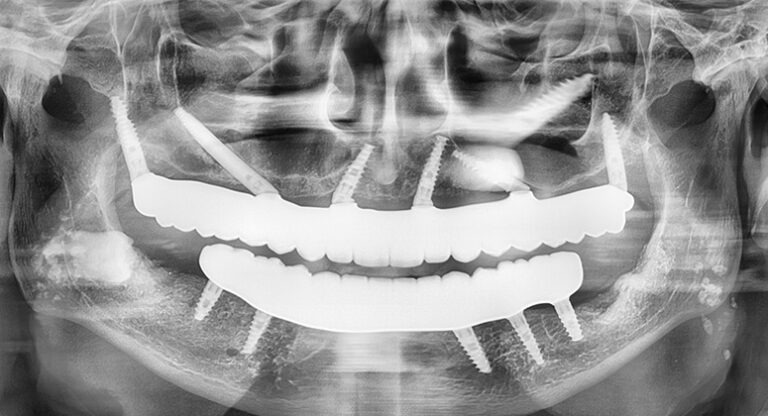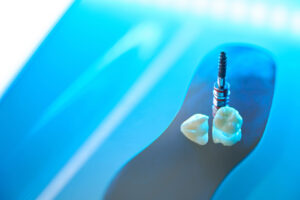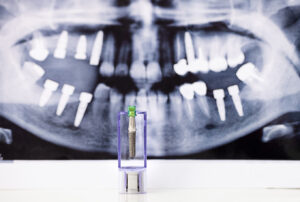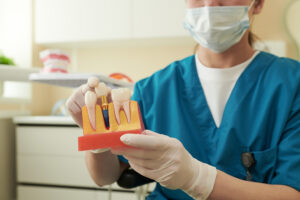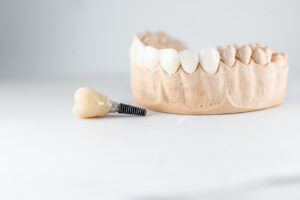What Are Full Arch Dental Implants and Who Is a Good Candidate?
This section explains the nature of full arch dental implants and identifies patients who may benefit from this treatment by outlining the technique, candidacy criteria, and the collaborative role of dental professionals.
What Are Full Arch Dental Implants?
Full arch dental implants consist of a complete set of prosthetic teeth supported by implants surgically placed along the jawbone. Made from titanium, these implants integrate with the bone via osseointegration, ensuring long-term stability. After integration, a custom prosthesis (bridge) is attached securely, restoring chewing efficiency, speech, and aesthetics. They serve as an alternative to traditional dentures and fixed bridges, providing comfort, functionality, and a natural appearance without relying on the gums.
Digital imaging and precise treatment planning are critical. Advanced computer-guided surgery ensures ideal implant placement in terms of angles and depth, reducing complications and contributing to a swift, comfortable recovery. Modern sedation techniques further minimize discomfort during surgery.
Who Qualifies for Full Arch Dental Implants?
Ideal candidates typically suffer from significant tooth loss in one or both jaws and have sufficient bone density. Even patients with compromised bone due to osteoporosis or long-term tooth loss may be eligible if bone grafting is performed. A thorough evaluation—including radiographic imaging and medical history—is used to rule out contraindications such as uncontrolled diabetes, severe periodontal disease, or heavy smoking. Good oral hygiene and overall health are essential factors for successful outcomes. Additional procedures like sinus lifts or bone grafts may be recommended for patients with reduced bone volume.
How Do Prosthodontists and Oral Surgeons Collaborate in This Procedure?
Successful outcomes depend on coordinated efforts between prosthodontists and oral surgeons. While the oral surgeon precisely places the titanium implants into the jawbone, the prosthodontist designs the final prosthesis tailored to the patient’s functional and aesthetic needs. They review digital scans and treatment models together to determine the best implant positions, ensuring optimal biomechanics and long-term stability. This close interdisciplinary collaboration reduces complications and creates a seamless transition from surgery to restoration.
What Are the Step-by-Step Stages of a Full Arch Dental Implant Procedure?
This section outlines the key stages in the full arch dental implant process, emphasizing careful planning and execution at each step.
How Is the Initial Consultation and Digital Planning Conducted?
The process begins with an initial consultation where the dental team reviews the patient’s oral health, medical history, and aesthetic expectations. Advanced tools like cone-beam computed tomography (CBCT) scans and 3D imaging provide a detailed view of the jawbone, helping to identify the optimal implant positions. Using this data, clinicians create a virtual treatment model that simulates implant placement and identifies any need for bone grafts. The entire treatment plan, including timelines and potential outcomes, is discussed with the patient, allowing for the anticipation of risks such as inadequate bone volume or interference with sinus cavities.
When Is Tooth Extraction Necessary Before Implant Placement?
Tooth extraction is necessary when teeth are severely decayed, damaged, or infected beyond repair. When multiple teeth are affected, extractions provide a clean foundation for implant placement. Occasionally, implants can be placed immediately after extraction (immediate loading), though sometimes a healing period is required to allow the bone to form a strong, stable base for the new implants.
What Is Bone Grafting and When Is It Required?
Bone grafting augments the jawbone’s volume and density when natural bone is insufficient for implant stability. If radiographic evaluation shows bone loss due to decay, periodontal disease, or trauma, a bone graft (from the patient, a donor, or a synthetic source) is recommended. The graft stimulates new bone growth, creating a robust foundation that enhances the likelihood of successful osseointegration. Additional healing time may be needed before proceeding with implant surgery.
How Are Implants Surgically Placed in the Jawbone?
Under local anesthesia (and sometimes sedation), the surgeon makes a small incision in the gum tissue to expose the jawbone. A precise channel is drilled according to the digital treatment plan, and titanium implants are inserted into these channels. These implants act as artificial tooth roots that eventually support the dental prosthesis. In some cases, temporary prostheses are attached immediately (immediate loading) to restore function and aesthetics during the healing period. Precise placement is vital; even a slight deviation can affect the final position of the prosthesis.
What Happens During the Healing and Osseointegration Phase?
After implant placement, a healing period of three to six months allows the jawbone to fuse with the titanium implants—a process known as osseointegration. During this phase, patients are advised to follow strict dietary and oral hygiene protocols and use prescribed medications to manage discomfort and swelling. Regular follow-up appointments, using clinical examinations and radiographs, ensure that osseointegration is progressing properly, which guarantees the long-term durability of the implants and supports the subsequent attachment of the prosthesis.
How Are Abutments Attached and Final Restorations Placed?
Once osseointegration is complete, a minor procedure is performed to attach abutments—small connectors linking the implants to the prosthesis. Impressions of the mouth are then taken to fabricate a custom prosthesis that matches the patient’s bite and facial contours. The final steps involve securely cementing or screwing the prosthesis onto the abutments, which restores full chewing function and a natural appearance. Adjustments are made to ensure proper occlusion and comfort, marking the successful completion of the treatment.
How Long Is the Recovery Time After Full Arch Dental Implant Surgery?
Recovery times vary among patients, with a general period during which healing, postoperative care, and a gradual return to normal activities are necessary.
What Are Common Post-Operative Symptoms and How Are They Managed?
Common post-operative symptoms include swelling, bruising, and mild discomfort at the surgical site; these typically resolve within days to weeks. Pain management is achieved through prescribed analgesics and anti-inflammatory medications, and dentists often recommend using ice packs during the first 48 hours. A soft diet is advised to reduce stress on the implants, and good oral hygiene practices—such as gentle brushing and the use of an antiseptic mouthwash—help prevent infection during the osseointegration phase.
When Can Patients Resume Normal Activities?
Patients are generally advised to rest for 24 to 48 hours post-surgery. Light activities may resume soon after, but rigorous exercise and heavy lifting should be avoided for at least one to two weeks. Return to routine activities, including work, is gradual and based on the patient’s recovery progress and overall health. Following the surgeon’s specific instructions and attending all follow-up appointments is critical for a safe transition back to daily activities.
What Are the Best Practices for Post-Operative Care?
Effective postoperative care is key to a successful recovery. Patients should maintain excellent oral hygiene by gently cleaning the surgical site after meals while avoiding direct brushing on the implant area initially. Dietary recommendations favor soft, non-abrasive foods to minimize irritation. Continued follow-up visits allow clinicians to adjust medications or care routines as needed, and avoiding tobacco and alcohol further supports healing by ensuring proper blood flow and osseointegration.
What Are the Typical Costs and Financing Options for Full Arch Dental Implants?
Full arch dental implant treatments involve multiple stages and advanced technologies, which contribute to their overall cost. This section outlines common cost components and financing options available to make treatment more accessible.
How Much Do Full Arch Dental Implants Usually Cost?
Costs typically range from $20,000 to $50,000 per arch. This estimate covers consultation, diagnostic imaging, surgical implant placement, any required bone grafting, and the final prosthetic restoration. While the initial expense may appear high, many patients view the procedure as a long-term investment in oral health and quality of life, given the durability and natural appearance of the implants.
What Are the Differences in Cost Between All-on-4 and All-on-6 Implants?
All-on-4 uses four strategically placed implants and is generally a more cost-effective option. In contrast, All-on-6 uses six implants, which may offer increased stability and longevity, especially beneficial for patients with compromised bone quality or greater bite force. Though All-on-6 may incur slightly higher costs due to additional implants and a more complex surgical approach, the extra stability can reduce the risk of complications over time.
What Financing and Insurance Options Are Available?
To ease the financial burden, many dental practices offer flexible payment plans or third-party financing that allows patients to pay over several months or years. Some dental insurance plans may cover a portion of dental implant costs; however, it is important for patients to verify their benefits. Additionally, practices may offer cash discounts or bundled pricing for implants in both arches. Discussing financial options during the initial consultation helps patients develop a payment plan that aligns with their budget while ensuring high-quality care.
What Are the Risks and Potential Complications of Full Arch Dental Implant Surgery?
Despite high success rates, full arch dental implant procedures carry certain risks and potential complications. Understanding these risks helps patients make informed decisions and follow preventive measures post-surgery.
What Are the Most Common Risks Associated With the Procedure?
Common risks include infection at the implant site, implant failure due to poor osseointegration, nerve damage, and sinus complications. Bleeding and swelling are typical immediate responses but usually resolve with standard care. There is also a risk of peri-implantitis, an inflammation of the soft tissue around the implants, which may compromise stability over time. Patients should discuss their individual risk factors with their dental surgeon prior to the procedure.
How Can Patients Recognize Signs of Infection or Implant Problems?
Key warning signs include persistent pain beyond the normal healing period, excessive swelling, redness, pus discharge, numbness, or changes in bite alignment. Regular follow-up appointments are critical for early detection, allowing prompt intervention to prevent further complications.
What Are the Solutions if Dental Implant Failure Occurs?
If an implant fails, treatments may include localized antibiotics, debridement, removal of the failed implant, and, if necessary, re-implantation after additional healing or bone grafting. The dental team tailors remedial approaches based on the severity of the failure to ensure long-term success.
What Do Patients Say About Their Full Arch Dental Implant Experience?
Patient testimonials provide valuable insights into the benefits and challenges of full arch dental implant procedures, highlighting improvements in function, aesthetics, and self-esteem.
What Are Typical Patient Reviews and Testimonials?
Many patients report a dramatic improvement in quality of life after receiving full arch implants. Testimonials often note restored ability to eat comfortably, speak clearly, and smile confidently, with minimal discomfort during the procedure and a rapid return to daily activities. These positive experiences help reinforce the reliability and effectiveness of the treatment.
How Do Before and After Photos Illustrate Treatment Success?
Before and after photos visually document the transformation achieved with full arch dental implants. They illustrate the changes from a compromised dentition with gaps and poor jaw structure to a full, natural-appearing smile that restores both function and aesthetics—building trust with prospective patients.
What Are Common Patient Concerns and How Are They Addressed?
Common concerns include surgical pain, implant longevity, aesthetic results, and cost. Dental teams address these by providing detailed consultations, managing pain effectively, utilizing advanced technology for precise outcomes, and offering financing options. Patient reviews further reassure future candidates by highlighting consistently positive experiences and successful recoveries.
How Can You Prepare for Your Full Arch Dental Implant Procedure?
Proper preparation is essential for a smooth surgical experience and optimal recovery. This section outlines steps patients can take to be both physically and mentally ready.
What Should You Expect During the Pre-Operative Consultation?
During this consultation, the dental team reviews the patient’s medical history, conducts clinical examinations, and takes radiographic images (such as CBCT scans) for accurate digital planning. Patients learn about each treatment phase—from implant placement to final restoration—and discuss any additional procedures, such as extractions or bone grafts. This session is critical for setting realistic expectations and building trust.
How Should You Prepare Physically and Mentally for Surgery?
Patients should follow recommendations regarding adjustments to medications, a temporary modified diet, and enhanced oral hygiene practices to reduce infection risk. Adequate rest and avoidance of smoking or alcohol further aid healing. Mentally, discussing concerns with the dental team and practicing relaxation techniques can significantly reduce anxiety and build confidence before surgery.
What Questions Should You Ask Your Dental Specialist?
It is important to ask detailed questions about the surgical process, expected recovery duration, pain management strategies, and success rates of similar treatments. Inquiries about financial aspects such as cost estimates, available financing plans, post-operative care, and emergency procedures ensure that patients are fully informed and comfortable with the treatment plan.
Final Thoughts
Full arch dental implants offer a transformative solution for patients with complete tooth loss. Through advanced digital planning and meticulous surgical techniques, the procedure restores function and aesthetics, vastly improving overall quality of life. With clearly defined stages—from consultation and planning to surgery, recovery, and aftercare—this treatment ensures high success rates and long-term stability. Patients are encouraged to prepare thoroughly, ask detailed questions, and strictly adhere to post-operative care instructions to achieve the best results from this innovative dental implant procedure.



